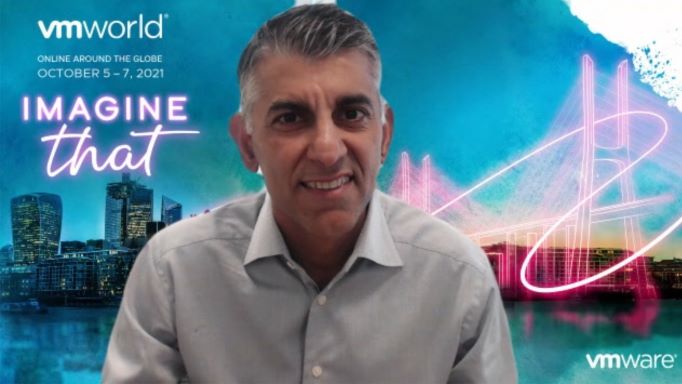 CLOUD
CLOUD
 CLOUD
CLOUD
 CLOUD
CLOUD
Leveraging the services of multiple cloud providers has been a reality for enterprises in recent years. But for a lot of them, that means having different architectures on several different clouds, which can be more complex, expensive and inefficient.
The challenge for a successful multicloud strategy is to run a single architecture across all clouds, which allows businesses to take a unified and simpler approach to development, management and security, according to Sumit Dhawan (pictured), new president of VMware Inc.
“The smart path to multiple cloud would be through a unified experience for developers, a control layer, which helps you orchestrate your applications in a unified fashion for your operators, and security done in a unified or a consistent fashion so that you know that you have the right governance,” he said. “Doing any other way would actually not be fruitful, and that’s what customers have had to face without a solution like VMware.”
Dhawan spoke with Dave Vellante, host of theCUBE, SiliconANGLE Media’s livestreaming studio, during theCUBE on VMworld event. They discussed Dhawan’s priorities as new president of VMware, the key challenges companies face in the multicloud era, how VMware solutions aim to address these issues, and the prospects for the company after the spinoff from Dell Technologies Inc. (* Disclosure below.)
While all major cloud providers have a wide range of services available to customers, enterprises that adopt a multicloud strategy can take advantage of the best of each, according to Dhawan. The flexibility and freedom to choose the ideal solutions is what is behind a business’ decision to follow this path.
“If you are really looking for the best possible solution for AI and ML, that may or may not sit in the cloud that you may have preferred for your compute and storage,” he explained, “[And] if you’re looking for identity solutions that integrate really well with the productivity applications that you have, that may not be the same cloud that you may have booked picked for AI and ML, you don’t need to make compromises.”
Another reason companies are turning to multicloud is that it’s risky to make the entire business depend on a single provider. “If there is risk, there is cost,” Dhawan said.
In fact, VMware customers have already decided on a multicloud infrastructure. In a recent study, the company found that 73% of its clients are already running their applications on different providers.
“This is no longer something for the future; it’s here today,” he said. “They’re just facing these challenges today with multicloud.”
VMware’s mission is to abstract the underlying complexity of these multiple clouds and make them look like one.
“We are providing our customers that foundation so that they can enable multicloud and drive their own innovation agenda at the pace that they want to,” Dhawan said. “We did that in the past for data center technologies or mobile devices. We’re bringing the same value proposition now in the world of multicloud.”
VMware bases its solutions for multicloud on two main pillars: networking and security. The understanding is that companies with a multicloud strategy want to ensure that their developer experience, their DevOps capabilities, and their infrastructure management features are present in all three types of applications: traditional enterprise apps, modern apps and emerging edge-native apps. They want there to be security for all environments as well, according to Dhawan.
To make this work, VMware’s first bet is built-in solutions. “You’re not installing agents, you’re not managing security thing on top, you’re not putting airbags into the car after the purchase; they come with the purchase,” he said. “You can choose to activate them or not activate them based on your price sensitivity.”
Its second bet is to make the solutions consistent, which means that the same capabilities, security framework, detection and response features are carried over all types of applications. The standard tooling for providing a single multicloud architecture is Kubernetes, according to Dhawan.
“What we are seeing is tooling needs to be done in a way so that our customers can manage from infrastructure to their platform, all via code, all standard, like Kubernetes,” he explained. “While at the same time, this tooling is done in a fashion so that the entire VMware Cloud and the entire VMware Tanzu platform can be controlled in a fashion that fits into customer’s entire environment on how they manage it overall.”
Here’s the complete video interview, part of SiliconANGLE’s and theCUBE’s coverage of theCUBE on VMworld event. (* Disclosure: TheCUBE is a paid media partner for theCUBE on VMworld event. Neither VMware, the sponsor for theCUBE’s event coverage, nor other sponsors have editorial control over content on theCUBE or SiliconANGLE.)
Support our mission to keep content open and free by engaging with theCUBE community. Join theCUBE’s Alumni Trust Network, where technology leaders connect, share intelligence and create opportunities.
Founded by tech visionaries John Furrier and Dave Vellante, SiliconANGLE Media has built a dynamic ecosystem of industry-leading digital media brands that reach 15+ million elite tech professionals. Our new proprietary theCUBE AI Video Cloud is breaking ground in audience interaction, leveraging theCUBEai.com neural network to help technology companies make data-driven decisions and stay at the forefront of industry conversations.